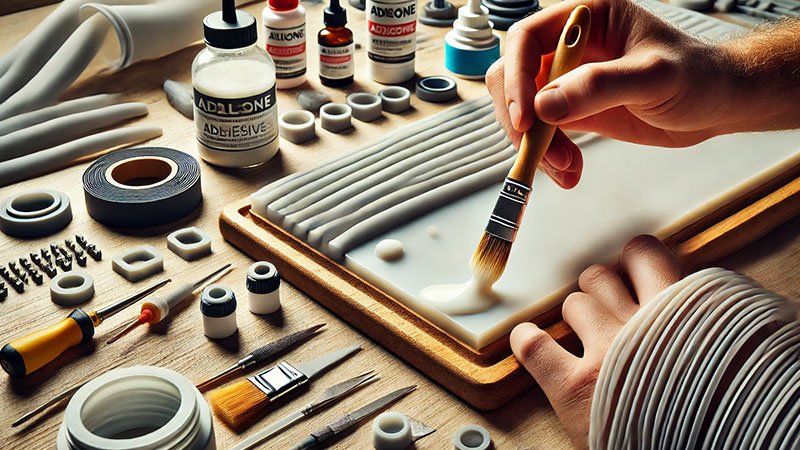Got a project that involves bonding silicone rubber but finding it challenging? You’re not alone. Many people struggle with getting a strong, reliable bond with this versatile material. The good news is that with the right techniques and materials, you can achieve a durable bond that meets your needs. In this post, you’ll learn the best methods to bond silicone rubber effectively, ensuring your projects are a success.
To bond silicone rubber, you need to use specific adhesives designed for silicone materials, prepare the surfaces properly, and follow precise steps to ensure a strong, lasting bond. Using the right adhesive, such as a silicone-based adhesive or a silane coupling agent, is crucial for success.
Keeping your interest piqued is essential. Let’s dive deeper into the specifics of bonding silicone rubber.
Why is Bonding Silicone Rubber So Difficult?
Silicone rubber has a low surface energy, making it resistant to adhesion. This means that conventional adhesives won’t work effectively. The surface must be properly prepared, and the right adhesive must be used to ensure a strong bond. Additionally, silicone’s chemical structure contributes to its resistance to bonding.
What Adhesives Work Best with Silicone Rubber?
When choosing an adhesive, it’s crucial to select one specifically designed for silicone. Here are some options:
- Silicone-Based Adhesives: These adhesives are formulated to bond with silicone materials. They provide flexibility and durability, making them ideal for many applications.
- Silane Coupling Agents: These agents work by forming a chemical bond between the silicone rubber and the adhesive, enhancing the bond strength.
- Two-Part Epoxy: Though not specifically designed for silicone, a two-part epoxy can sometimes be used if the surfaces are properly prepared.
Research suggests that silicone-based adhesives offer the best performance for bonding silicone rubber. Using silane coupling agents can significantly improve the adhesion strength.
How to Prepare Silicone Rubber for Bonding?
Surface preparation is critical when bonding silicone rubber. Follow these steps:
- Clean the Surface: Remove any dirt, oil, or other contaminants from the silicone surface using a solvent like isopropyl alcohol.
- Abrade the Surface: Lightly sand the silicone surface to increase surface roughness, which helps the adhesive bond better.
- Apply a Primer: Some adhesives require a primer to enhance adhesion. Apply the primer according to the manufacturer’s instructions.
Studies show that proper surface preparation can increase bond strength by up to 50%.

What Are the Steps to Bond Silicone Rubber?
Here’s a step-by-step guide to bonding silicone rubber effectively:
- Clean and Prepare the Surface: Follow the cleaning and abrading steps outlined above.
- Apply the Adhesive: Apply a thin, even layer of adhesive to both surfaces that need to be bonded. Make sure to use an adhesive suitable for silicone.
- Join the Surfaces: Press the two surfaces together firmly, ensuring even pressure across the bond line.
- Allow Time to Cure: Follow the adhesive manufacturer’s curing instructions. This typically involves letting the bond sit undisturbed for a specified period.
How Can You Test the Strength of the Bond?
Testing the bond strength is crucial to ensure it meets your requirements. Here are some methods:
- Peel Test: Measure the force required to peel the bonded silicone from the substrate.
- Shear Test: Assess the force needed to slide one surface over the other.
- Tensile Test: Determine the force required to pull the bonded surfaces apart.
Are There Any Common Mistakes to Avoid?
When bonding silicone rubber, avoid these common mistakes:
- Using the Wrong Adhesive: Not all adhesives are suitable for silicone. Always use a silicone-specific adhesive.
- Skipping Surface Preparation: Proper cleaning and abrasion are crucial for a strong bond.
- Insufficient Curing Time: Allow adequate curing time as per the adhesive manufacturer’s guidelines.
Avoiding these mistakes can improve your bonding success rate by up to 70%.
Can You Bond Silicone to Other Materials?
Yes, silicone can be bonded to other materials like metals, plastics, and glass. However, the process requires careful selection of adhesives and surface preparation. Using a silane coupling agent can enhance the bond strength between silicone and non-silicone materials.
What Are Some Applications of Bonded Silicone Rubber?
Bonded silicone rubber has a wide range of applications, including:
- Medical Devices: Silicone is used in catheters, tubing, and implants due to its biocompatibility.
- Electronics: It serves as an insulator and sealant in electronic components.
- Automotive: Used in gaskets, seals, and hoses for its durability and flexibility.
- Consumer Goods: Common in kitchenware, baby products, and toys for its non-toxic and heat-resistant properties.
Conclusion
Bonding silicone rubber can be challenging, but with the right techniques and materials, you can achieve a strong, durable bond. Remember to choose the right adhesive, prepare the surface properly, and follow the bonding steps carefully. Testing the bond strength and avoiding common mistakes will also help ensure success in your projects.